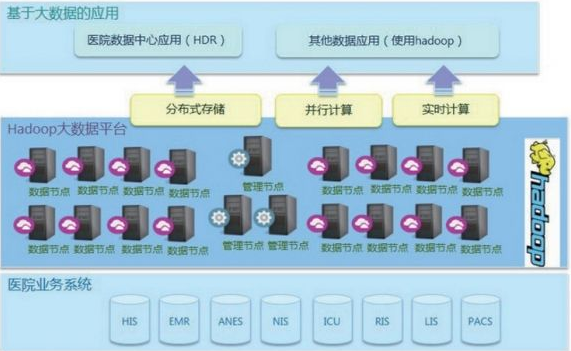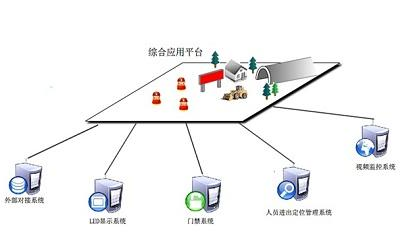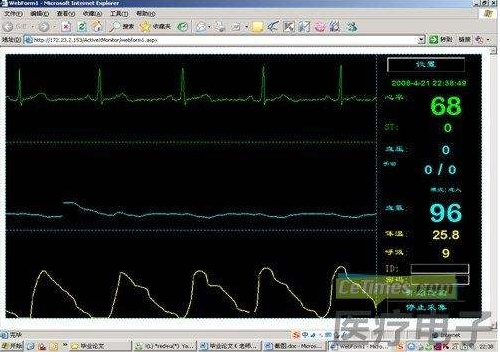Cloud computing is a translation of English Cloud CompuTIng, which appeared only in early 2008. It was Dell who first proposed Cloud CompuTIng from the enterprise level, but the IBM-Google parallel computing project and Amazon EC2 products have a deep impact on the concept of cloud computing. Then more and more media, companies, and technicians began to chase cloud computing. Even putting a lot of IT innovations into the cloud computing concept, enabling cloud computing concepts and industries to be promoted and developed, forming a complete one that now includes IaaS, PaaS, XaaS, and numerous hardware manufacturers and infrastructure operators. Industry chain.
First, the concept, characteristics and application of cloud computing 1. What is cloud computingAt present, there is no unified definition of the concept of cloud computing in the world, but in general we can be divided into two broad categories of concepts: one is narrow sense; the other is generalized.
(1) Narrow cloud computingThe network that provides the resources is called the "cloud." The resources in the "cloud" can be expanded infinitely by users, and can be obtained at any time, used as needed, expanded at any time, and paid for by usage. This feature is often referred to as the use of IT infrastructure like hydropower.
(2) Generalized cloud computingThis resource pool is called a "cloud." "Cloud" is a virtual computing resource that can be self-maintained and managed, usually a large server cluster, including computing servers, storage servers, broadband resources, and so on. Cloud computing centralizes all computing resources and is automatically managed by software without human intervention. This eliminates the need for application providers to worry about cumbersome details, to focus more on their business, to innovate and reduce costs. For example, this is like switching from the old single generator mode to the centralized power supply mode of the power plant. It means that computing power can also be circulated as a commodity, just like gas and water, easy to access and low cost. The biggest difference is that it is transmitted over the Internet.
In general, cloud computing is the development of parallel computing, distributed computing, and grid computing, or the commercial implementation of these computer science concepts. It is the result of a mixed evolution of virtualization, utility computing, infrastructure as a service, platform as a service, and software as a service.
2. The principle of cloud computingCloud computing is the development of distributed processing (Distributed CompuTIng), parallel processing (Parallel CompuTIng) and grid computing (Grid Computing), providing services to Internet users by using distributed computers that are not local or remote servers (clusters) (computing, Storage, software and hardware services, etc., thus effectively improving the utilization of hardware and software resources, enabling users to enjoy the convenience of high-performance parallel computing through cloud computing.
3. The main features of cloud computingThe National Institute of Standards and Technology of the United States has summarized five basic characteristics of cloud computing: First, self-service on demand. Consumers can unilaterally deploy computing resources (such as server time and network storage) to automatically meet demand without the need for manual coordination by service providers. The second is ubiquitous network connectivity. Cloud computing resources can be accessed over the network and accessed through standard mechanisms that enable users to use cloud computing through heterogeneous thin client platforms or thick customer platforms (mobile phones, laptops, PDAs, etc.). . The third is a geographically unrelated resource pool: the cloud computing service provider adopts a multi-user mode to dynamically allocate and reallocate physical resources and virtual resources according to user requirements. Users usually do not need to know the specific location of these resources, including memory, processor, memory, network, virtual machine and so on. The fourth is to deploy resources quickly and flexibly: cloud computing providers can quickly and flexibly deploy cloud computing resources to quickly zoom in and out. For users, cloud computing resources are often unlimited and can purchase any number of resources at any time. The fifth is service billing: By billing different types of services, the cloud computing system can automatically control and optimize resource utilization. It can monitor and control resource utilization and form reports to provide transparency to cloud computing providers and users on the services they use.
Combined with the meaning of the above cloud computing, some characteristics of cloud computing are obtained.
(1) Large scale. The scale of cloud computing is huge, and Google Cloud Computing already has more than 1 million servers, which also makes Google's search engine the number one in the world.
(2) Virtuality. Through cloud computing, users can use a laptop or a mobile phone to obtain application services through network services without worrying about the specific location of the application running anywhere.
(3) High reliability. Cloud computing provides a strict rights management strategy, which reduces the traditional data loss, virus intrusion and other problems, and high reliability of data storage.
(4) Strong scalability. In order to meet the needs of application and user scale growth, the scale of the "cloud" can be dynamically expanded.
4. Cloud computing applicationsFor the average user, the most commonly used areas of cloud computing are email, web search (Google or Baidu), photo sharing (Flickr), video sharing (Youtube, potatoes), and Google Maps. As long as there is a browser for Internet tools such as computers or mobile phones, you can quickly get the information of distant computers in a matter of seconds, so that information is readily available, like electricity and running water.
In addition, for software designers and scientists, cloud computing provides powerful computing power to simulate experiments such as nuclear bomb explosions and DNA structures. What is the business opportunity for cloud computing? According to data from the International Data Center (IDC), the average annual growth rate of cloud services is expected to reach 26% in the next five years; Merrill Lynch estimates that the global cloud computing market will reach $95 billion in 2013; market research institutions Cloud computing ranks first in the IT industry's top ten trends. According to the report, 400 of the Fortune 500 companies will use a variety of cloud computing services by 2012.
5. Status of cloud computing developmentBecause cloud computing is the result of a hybrid evolution of multiple technologies, its maturity is high, and it is driven by large companies, and its development is extremely rapid. Big companies like Amazon, Google, IBM, Microsoft, and Yahoo are pioneers in cloud computing. Many successful companies in the cloud computing field include Salesforce, Facebook, Youtube, Myspace and more.
In China, the development of cloud computing is also very rapid. On May 10, 2008, IBM opened its first cloud computing center in China in Wuxi Taihu New City Science and Education Industrial Park. On June 24, 2008, IBM established the second China cloud computing center in the IBM China Innovation Center in Beijing - IBM Greater China Cloud Computing Center; Century Internet launched the CloudEx product line, including complete Internet hosting services, based on The online storage virtualization service, a series of Internet cloud computing services for individuals and enterprises to carry out Internet cloud backup data security services; China Mobile Research Institute started cloud computing early, and has completed the cloud computing center experiment.
There are two main directions for cloud computing in the future: one is to build a large-scale underlying infrastructure that is tightly integrated with applications, so that applications can scale to a large scale; the other is by building new types of cloud computing applications. Provide a richer user experience on the web. The first development trend can be reflected in the existing research situation of cloud computing. In the construction of cloud computing applications, many new social service networks, such as facebook, have already reflected this development trend. Then began to focus on how to integrate multiple services through the cloud computing infrastructure.
6. Problems with cloud computingFrom the current application situation, cloud computing technology has the following shortcomings: (1) using the best virtualization technology, users can not migrate applications to the "cloud"; (2) enterprise tasks migrate to the cloud environment, which requires huge Workload; (3) Virtualization of all IT assets can be achieved only with the consent of the user, forming an “internal cloud†that seamlessly operates “external cloudâ€; (4) does not really provide cloud computing services according to actual needs, and can press The actual use of resources to pay; (5) the data center provides management application software and the company's existing management application software integration is poor; (6) cloud computing does not have a unified standard to regulate, enterprises are difficult to adopt on a large scale.
In addition, experts at the Black Hat Security Conference in August 2009 raised five security flaws regarding cloud computing security issues: (1) cloud computing does not provide adequate legal protection; (2) cloud computing has no hardware ownership; and (3) cloud computing needs strong (4) Do not trust virtual machine instances created by third-party developers; (5) In any case, enterprise information technology managers need to rethink the configuration on the cloud.
Cloud computing is now at an early stage, and it requires people's in-depth understanding and efforts to properly manage complex resources. Therefore, its popularity will take some time.
Second, the development and current status of ECG remote monitoringIn modern society, cardiovascular disease is a serious threat to human health and life. It is the leading cause of death in the Chinese population. The prevention and diagnosis of cardiovascular disease is of great significance to the whole society. Because of the contingency and suddenness of cardiovascular disease, it is especially important to perform ECG monitoring on the patient population in daily life.
The ECG telemonitoring system originated from the Holter system. Early family-type ECG monitoring system for some patients who have undergone cardiac surgery, using electronic instruments to record, store the patient's daily electrocardiogram and other important physiological parameters, and periodically send the data to the clinic for diagnosis, patients can stay away from the hospital for monitoring . Early family ECG monitoring should analyze the ECG data after the end of monitoring. It is not real-time, and the doctor cannot get timely diagnosis and treatment. Moreover, because its storage capacity is too small, only a very small amount of ECG data can be stored, and the integrity of the data cannot be guaranteed. Some valuable ECG data is inevitably lost, which greatly reduces the accuracy of the diagnosis.
With the rapid development of modern communication technology and its application in the medical field, in recent years, the ECG telemonitoring system has undergone a revolutionary change. Holter has gradually evolved into a front-end device for the ECG tele-monitoring system, which will be the traditional Holter and The trend of combining computer networks and mobile communication technologies is becoming more apparent. With the popularization and development of macro infrastructure such as the Internet and mobile communication networks, ECG monitoring has been rapidly developing in both directions along the Internet and wireless mobile monitoring.
The Internet-based remote ECG monitoring system uses the ECG monitoring client to collect the patient's ECG signal, and then transmits the ECG signal to the monitoring center server via the Internet, waiting for the medical staff to process and diagnose the patient's electrocardiogram. The entire system generally consists of three parts: the client terminal, the Internet, and the management center workstation. The client terminal consists of an ECG signal collector and an Internet-connectable workstation that performs functions such as collecting patient ECG signals, performing simple data processing, and uploading data to the Internet. According to different ways of accessing the Internet, the system has different design schemes, mainly including PSTN (Published Switched Telephone Network), ISDN, Ethernet, and the like. The remote ECG monitoring management center workstation is generally equipped with a high-performance server, which can receive patient ECG data in real time, store and analyze processing data, manage patient basic data and ECG data, and network security management.
The ECG wireless monitoring system based on the mobile communication network uses a portable ECG signal monitor to communicate data with the monitoring center using wireless communication technology. Wireless transmission does not require cable media, users can be monitored by the monitoring center anytime, anywhere, regardless of time or location. With the improvement of communication technology and computer network technology, the research hotspot of ECG remote monitoring in recent years is the close integration of wireless communication technology and Internet technology. Combining the two technologies makes up for the shortcomings of restricting the subject to a fixed environment when relying solely on the Internet; at the same time, it also compensates for the fact that the data of the subject can only be transmitted between the mobile monitoring terminals when relying solely on wireless technology. Therefore, the resulting cost is high, it is difficult to popularize, and data processing and analysis means are single.
The wireless, network and humanization of ECG monitoring system is the development trend. Portable, modular, easy-to-operate and low-cost ECG monitoring products will become the mainstream of the future market. The third-generation mobile communication 3G technology that is gradually developing can greatly increase system capacity, improve communication quality and data transmission rate, and utilize seamless roaming technology between different networks to better connect wireless communication systems to the Internet. It will provide a more stable and stronger technical foundation for the ECG telemonitoring system. The ECG telemonitoring system integrates the development of biomedical engineering, information technology and communication technology, and can fully utilize the resource advantages of mobile communication networks and the Internet. In the near future, it will certainly play a role in the prevention and treatment of heart disease. More and more important role.
Third, the application of cloud computing in medical informationization and ECG remote monitoringThe cloud computing that has emerged in the past two years is to centralize all computing resources and implement automatic management by software without human intervention. It means that computing power can also be circulated as a commodity, as easy as gas and water, and at a low cost. Therefore, medical and health enterprises can carry out informatization construction by purchasing computing power without having to build related facilities, which makes it unnecessary for enterprises to worry about the cumbersome details and to be more focused on their own business. The emergence of cloud computing technology will bring a new understanding of medical information construction. Through the cloud computing platform, hospitals can “outsource†websites, email systems, information management systems, remote monitoring systems, and data centers and security systems to cloud computing service providers, no longer have to worry about how to build and maintain a server environment. How to purchase and upgrade system software, application software and anti-virus software, how to prevent hacking. Whether it's data services or application computing, everything is directly available on the web. It's like using water and electricity. End users only need to open switches or faucets to get and enjoy the service, while power plants and water plants with huge resources are responsible for providing the most professional production and maintenance at the other end of the cloud. .
Figure 1. Cloud storage service model in medical informatization
Based on the idea of ​​using "cloud computing" to realize remote monitoring of physiological parameters, we designed a multi-parameter remote monitoring system based on B/S architecture, and its structure is shown in Figure 2. The entire system consists of the central monitoring server software (cloud), client browser and multi-parameter collector of the monitoring center. The server-side software (cloud) can accept data transmission requests from two clients, and realize remote real-time monitoring of multiple patient physiological parameters based on the Internet. The client adopts the B/S architecture, no need to install any client program, and can view and send physiological parameters and waveforms in real time by opening the browser (see Figure 3). The remote central monitoring system based on B/S architecture facilitates the deployment and maintenance of client software, and extends the central monitoring system from the hospital ward to the community or home, providing a new solution for the popularization and networking of medical instruments.


In the new wave of medical reform, the informationization of medical services will be an inevitable trend. Through information technology, the sharing of resources among medical and health institutions can be achieved, and the optimal integration and maximum synergy effect of medical service resources can be realized. It will be very impressive. The cloud computing concept and technology that use computing resources as a service will definitely change the development concept and construction mode of traditional medical informatization, and play a vital role in promoting the process of medical informatization.
Liquid Crystal Display For Instrument
Liquid Crystal Display For Instrument,Large Industrial Precision Lcd Display,Small Industrial Body Thin Lcd Display,Precise Liquid Crystal Display
Dongguan Yijia Optoelectronics Co., Ltd. , https://www.everbestlcdlcm.com